On October 13, 2020, rapper Logic shocked the world when he paid $220,574 for a Pokémon card.
That’s right — he paid the price of a brand new Ferrari or a three-bedroom home in Ohio for a shiny cardboard picture of a lizard.
Not to be outdone, YouTuber Logan Paul paid even more for a rare Pikachu in 2021. A lot more. $5,275,000 to be precise.
Granted, it’s a really cute Pikachu holding a paintbrush, but still:

Paul’s record-shattering purchase was part of the great Pokémon card resurgence that began during the early days of COVID-19. And considering cards are still selling for well into the six figures in 2022, “Pokemania 2.0” has clearly outlasted the pandemic and shows no signs of losing steam.
With Pikachus selling for more than Picassos, you might be wondering:
- Are any of your Pokémon cards worth anything?
- With $0.50 cards from the 1990s worth millions in 2022, should you be investing in Pokémon cards instead of index funds?
Why Are Pokémon Cards Suddenly Popular Again?
Pokémon card collecting has always been popular, as evidenced by the over 50 billion cards now in circulation.
But even the makers of Pokémon cards were caught off guard when demand began skyrocketing back in mid-2020. In addition to being fun, addictive, and nostalgic, collecting Pokémon cards during the COVID-19 pandemic even promised a potential form of economic relief.
After all, each $4 booster pack could contain a Charizard GX SV 49 worth $1,800.
Soon, celebrities and influencers picked up on the resurging popularity of Pokémon cards.
In early October, Logan Paul live-streamed an event where he opened a rare box of cards worth $200,000 in front of his 22 million subscribers.
Pokimane and other influencers quickly followed suit, offering a Pokémon-flavored version of the ever-popular “unboxing” videos.
Things seemingly came to a head on October 13, 2020, when rapper Logic bought a first-edition, holographic Charizard for an eye-watering $220,574. But now that someone’s bought a Pikachu for more than four times that in 2022, the world’s first seven-figure Pokémon card deal is all but inevitable.
Are Any of Your Old Pokémon Cards Worth Anything?
Like many Millennials in their 30s, I had a binder full of Pokémon cards that my family and I held onto for years. Upon hearing the news that some of them might be worth a 401(k), I immediately called up my mom.
Mom! Do you have any idea where my old Pokémon cards are??
Sadly, she didn’t. Our shared conclusion is that we likely donated them to a kid down the street years ago, along with my old airsoft stuff.
This deflating revelation immediately made me feel like the guy who paid 10,000 bitcoins for pizza.
However, if you’re also fretting over the location of your old Pokémon card collection, I actually have some “good” news for you:
Most Old Pokémon Card Collections Aren’t Worth Anything
The only rare Pokémon card I can distinctly remember having was a holographic Blastoise, which I (ironically) destroyed in the YMCA pool.
I cringed when that memory resurfaced. Surely that card is worth more than a used car today…
Turns out, you can actually buy a collector-condition Blastoise on Amazon for about $100.
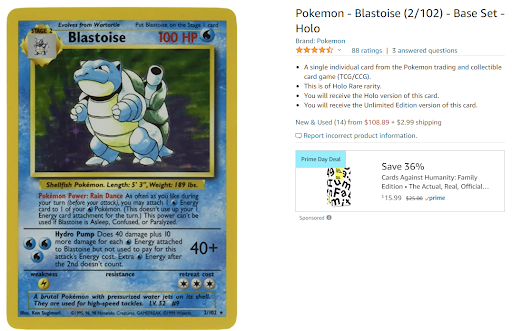
In fact, holographic Charizards aren’t selling for much more than that.
So what gives? Why are some Charizards worth $100 and others worth $200,000?
Well, unlike the $110 eBay Charizard, Logic’s prized Charizard is a:
- First Edition
- Shadowless
- PSA Gem Mint 10
Any card falling short of those high standards won’t be worth even 5% as much. So whether you’re looking to start investing in Pokémon cards or simply selling your old collection, let’s cover how to spot and appraise valuable Pokémon cards.
How to Spot Rare Pokémon Cards
I’m going to focus on cards printed from 1996 to 2000, for two reasons. Not only are the rarest cards from this era the most valuable, but they’re also the trickiest to identify.
The “Base Set” of Pokémon cards, or the OG cards from 1996 to 1999 that we all know and love, actually came in three flavors: 1st Edition, Shadowless, and Unlimited.
1st Edition
1st Edition cards are pretty self-explanatory — these were among the first wave ever printed and distributed, and as a result, carry the highest collector value.
1st Edition Base Set cards tend to fetch values ranging from $250 to $24,000, with the median hovering around a few hundred bucks. According to Old Sports Cards, the most valuable 1st Edition Base Set Pokémon cards are:
- Alakazam: $2,800
- Clefairy: $2,500
- Raichu: $2,500
- Venusaur: $2,200
- Mewtwo: $2,200
- Charizard: $24,000
- Blastoise: $5,500
- Chancey: $3,500
- Hitmonchan: $3,250
- Ninetales: $3,000
If you’re wondering why Logic paid 10x what a 1st Ed. Charizard is supposedly worth, it’s simply because card values are hard to predict. Your old rare Gyrados may be appraised at $1,500, but it may sell for $15,000 or $150, depending on the demand that day.
Even so, either scenario is worth a few minutes of rummaging through your old collection.
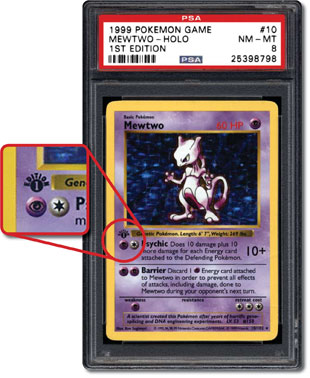
Thankfully, 1st Editions are easy to spot.
Wizards of the East Coast, the company that made Pokémon cards until 2003, left a stamp on each of their 1st Edition cards — so if you see this, you’ll want to encase the card in protective plastic ASAP.
Shadowless
Shadowless cards are the second-rarest breed of Pokémon card from the ’90s. These were the cards produced right after the 1st Editions, and are visually identical to their earlier counterparts save for a missing stamp.
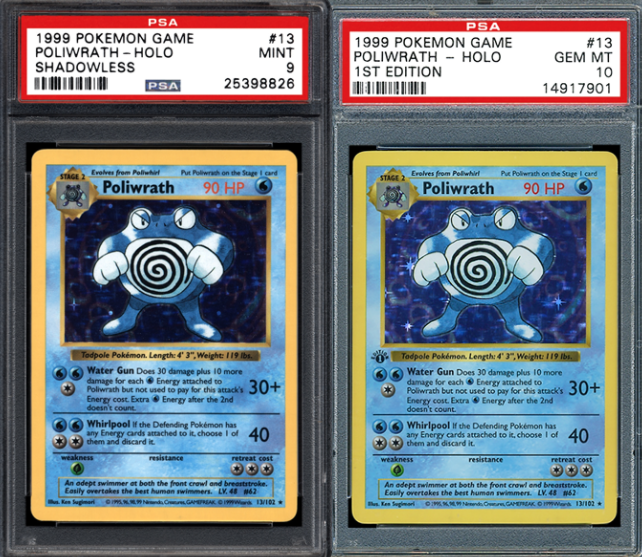
They got the nickname “shadowless” simply because they lack a shadowy background introduced in the next wave of cards, the Unlimited.
Shadowless cards aren’t the rarest, but they still fetch some solid beer money. According to TGGplayer, prices for shadowless cards range from $1 to $3,000, with the median being around $100. This makes them roughly one-tenth as valuable as their 1st Gen counterparts, and the most valuable 1st Gens are also the most valuable shadowless.
Unlimited
Unlimited cards make up the bulk of the printing run for the Base Set. These are by far the most common and thus carry much less value for collectors these days. There’s a 95% chance the Blastoise I ruined was a Base Set Unlimited worth well under $100, so I’m not too bummed out about it.
You can spot a Base Set Unlimited card by the much thicker font and iconic “shadow” behind the frame of the Pokémon. To illustrate, here are all three editions from the Base Set, back-to-back:
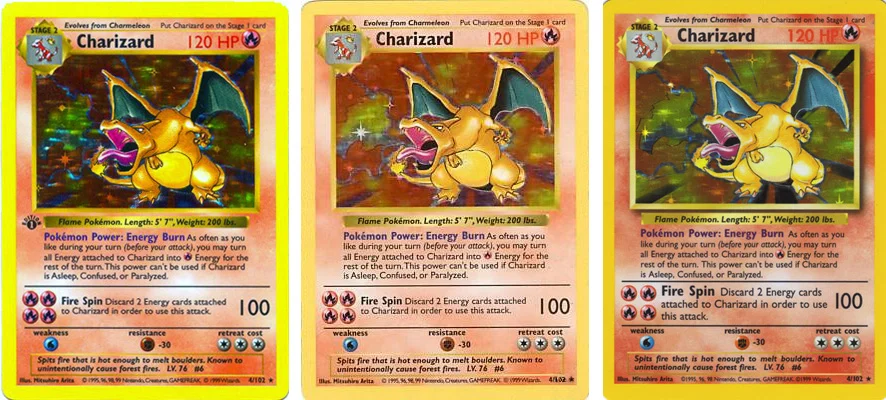
The last set worth mentioning from this era is Base Set 2. These cards were launched in the year 2000, and were essentially a fresh run of Base Set Unlimited cards.
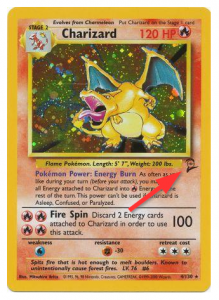
You can spot them by the number “2” with a Pokeball emblazoned on it, positioned next to your Pokémon’s weight.
Collectors tend to value Base Set 2 cards at or slightly below Base Set Unlimited cards.
For better or worse, over 90% of the Pokémon cards from the 90s aren’t worth much. So if you’re panicking over your lost collection, fret no longer — it’s probably worth little more than a few good memories.
However, if you do find a 1st Edition or Shadowless card in your old collection, here’s what to do next.
How to Sell Your Rare Pokémon Cards
Get the Card’s Condition Graded by the PSA
Let’s say you find your old cards and come face-to-face with a 1st Edition Chancey card worth up to $3,500. Sweet!
Now, how do you sell it?
Your first step will be to temper your expectations. Although auction sites will list “estimated values” of thousands of dollars, the resale value at that moment in time could be 10x more or less than that.
In addition to checking TCGplayers, a good way to rapidly appraise your card’s value is to browse recently sold listings on eBay. You can do so by searching for your card, clicking Advanced, and checking the Sold listing box.
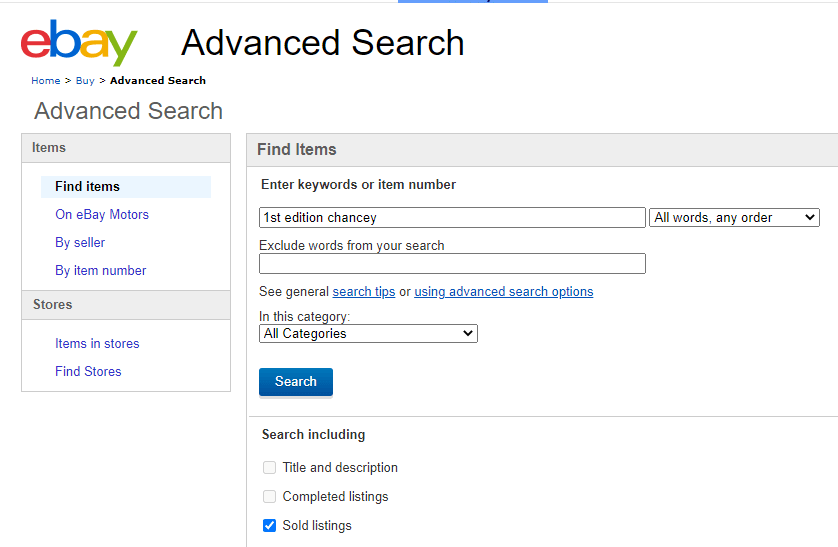
Looks like one recently sold for $1,875 USD. Not bad.
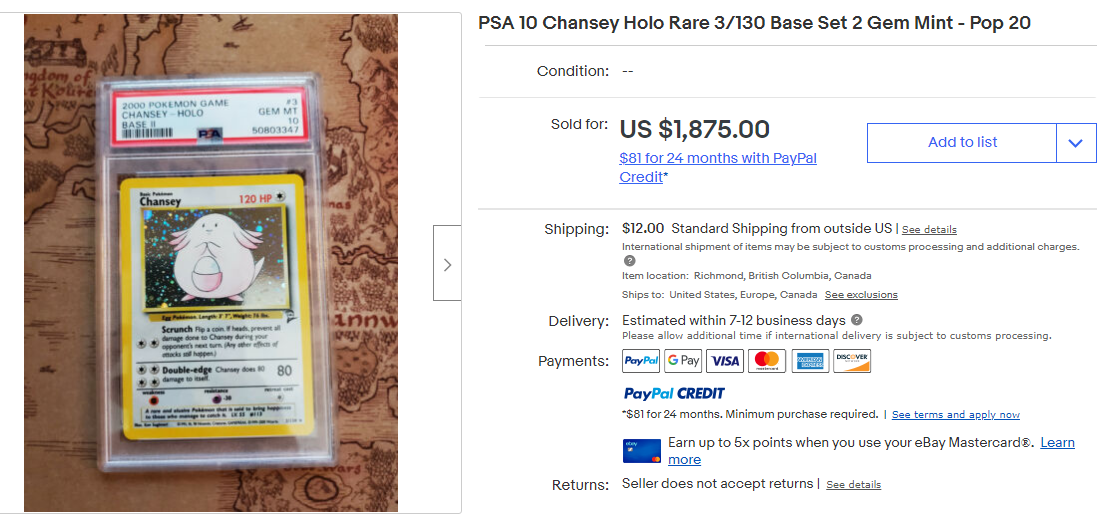
This particular Chancey was both encased and graded by a company called the PSA, or the Professional Sports Authenticator. The PSA grades the condition of rare trading cards on a quality scale of 1-10, with 10 being known as “Gem Mint.” Cards graced by Gem Mint status aren’t just free of manmade scuffs — they’re free of the most microscopic factory defect.
Generally speaking, most cards handled by children before retiring into a shoebox will score a PSA of 7 or lower, selling for about 5% to 10% of Gem Mint price.
Unfortunately, the news gets worse — any card worth over $500 will likely need PSA grading, and the PSA is currently so overwhelmed that they’ve temporarily suspended most services.
Therefore, you’re left with three options:
- Roll the dice on PSA’s $300 Super Express service.
- Wait until they resume basic services.
- Sell your cards without a professional appraisal for ~10%-40% of their PSA-graded value.
Regardless of which option you pick, how and where should you sell your rare Pokémon cards?
Sell Your Cards
There’s no right or wrong place to sell your rare Pokémon cards. Here are some of the most popular options, sorted by their pros and cons:
| Marketplace | Pros | Cons |
|---|---|---|
| eBay | Maximum traffic and views | 10% seller fee plus 2.5% PayPal transaction fee |
| PWCC (trading card auction house) | Attracts wealthier buyers | 8% – 15% seller fee, requires third-party appraisal |
| Facebook Marketplace | Zero seller fee when sold locally | Less traffic, in-person sales carry risk |
| Etsy | Low seller fees (5%) | Less traffic |
Is It Worth Investing in Pokémon Cards Now?
With the values of rare Pokémon cards outlasting many cryptocurrencies, is it really so crazy to “invest” in a Blastoise?
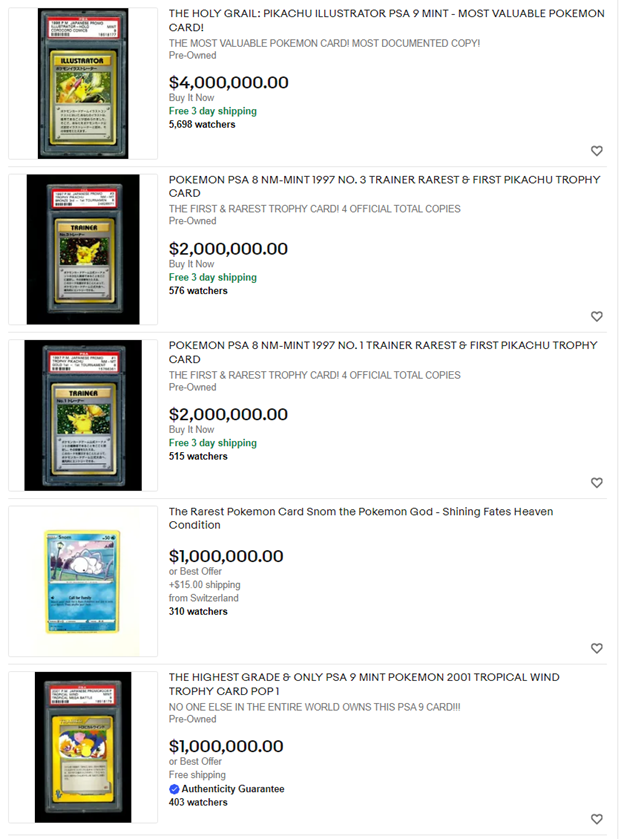
Now that you know how to effectively spot a rare, valuable Pokémon card, here are some reasons you should (and shouldn’t) buy it.
Reasons to Invest in Pokémon Cards
Here are four compelling reasons why a small investment in Pokémon cards this year may pay off down the road:
- Supply is dwindling and demand is rising. Economics 101 tells us that when demand for an asset outstrips supply, prices rise. Nobody’s making new 1st Edition Pokémon cards and demand is rising at the moment, so it’s reasonable to suggest prices will rise in the short term as well.
- They’re easy to buy and sell. Compared to real estate or rare cars, Pokémon cards are among the easiest forms of property to buy and sell. No surprise leaks or expensive brokers — you always know exactly what you’re buying or selling.
- They’re easy to store. Similarly, trading cards are perhaps the single easiest physical investment to store and maintain. Pokémon cards don’t need cleaning, climate-controlled storage, or even insurance — just a plastic sleeve and a safety deposit box.
- The upside could be huge. In 2017, if you’d invested $500 in an S&P 500 index fund you’d have about $1,500 now. If you’d put that money into a PSA 9 Charizard instead, you’d have $5,500.
Reasons Not to Invest in Pokémon Cards
There’s a potential upside to investing in Pokémon cards, but as with all unique investments, the cons deserve to be heard:
- “Pokemania” may end soon. As with any investment, hype, and influencer marketing drive up the price of investments. So, prices may quickly deflate.
- Appraisal is difficult and expensive. If you plan to invest in a card worth $5,000+ one day in the future, you’ll have to pay PSA $300 just to reappraise it — and if the market’s hot enough to sell it, there’s a chance the company will become overwhelmed again and suspend services, jeopardizing your timing.
- Cards could get lost, stolen, or damaged. Pokémon cards only hold their value if they remain in 100% pristine condition. If a PSA 10 Charizard drops to PSA 9 while it’s in your possession, it loses 80% of its value.
- Demand for rare collectibles is extremely fickle. Sure, demand for rare Pokémon cards may be high right now, but it could easily disappear overnight as young investors and collectors turn to something else. The same thing happened with Beanie Babies, some of which sold for $10,000 in the late ’90s and are worth less than $10 now.
What Are Pokémon Cards?
For the uninitiated, Pokémon Cards are part of the Pokémon Card Trading Card Game that originally launched in 1996. Back then, the original set contained just 151 cards — one for each OG Pokemon.
In simplest terms, Pokémon cards are baseball cards but for adorable Japanese “Pocket Monsters.”
Since then, Pokémon has exploded into the world’s most valuable media franchise, valued at over $100 billion worldwide. For comparison, that’s more than Star Wars, Spongebob, and James Bond combined.
Fueling two decades of meteoric growth was a steady stream of new Pokémon creatures — and thus new cards — to collect. There are around 898 total Pokémon and over 9,100 Pokémon cards to collect in the English market.
Not all 9,100 cards are available on store shelves at once, of course. The Pokémon Company International, the folks who make Pokémon cards, publish and release cards one “generation” at a time, with each generation lasting about two years.
In total, there have been eight generations of Pokémon cards since 1996. And as the next generation of cards begins appearing on store shelves, the previous generation tends to sell out. At that point, it’s no surprise that certain cards begin shooting up in value.
The Bottom Line
Pokémon cards have made a welcome resurgence since the pandemic, providing ’90s and 2000s babies a delightful form of nostalgic escapism. For some of us, the rise in old card values might’ve even provided a pinch of economic relief.
However, despite some high-profile sales and speculation of enduring popularity, rare Pokémon cards remain a dubious investment at best. Even if you put aside the high fees associated with appraising and selling rare cards, the likelihood that you’ll see positive returns on your investment remain slim to none. In short, the risk that you’ll lose money investing in Pokémon cards is just way too high.
For assets that are way more likely to appreciate in value, learn about investing in index funds.